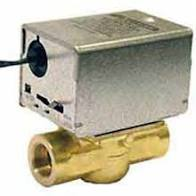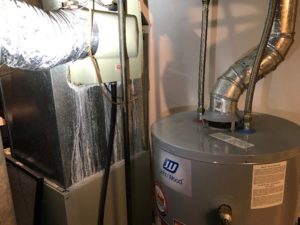Table of Contents
Inspection Report Explanations
Disclaimer: All terms and explanations found here or in your report are for information purposes only and must be verified by the qualified licensed technician to which they are pertaining to.
AFCI
Arc Fault Circuit Interrupter. A means by which the plug-in wall receptacle or the circuit breaker in the main panel can recognize the characteristics of an electrical fault, or arcing within that electrical circuit. Electrical arcing can occur when the circuit wiring, or an extension cord on that circuit becomes pinched or damaged in some way, causing an arc which has the potential for a fire.
Anti-tip bracket
Anti-tip bracket is a metal bracket fastened to the floor or wall behind the stove. When the stove is pushed back into its normal operating position, this bracket, when installed correctly, will cradle the back leg of the stove which prevents the stove from tipping forward should a curious child open and stand on the oven door while items are cooking on the stove top, consequently scalding the child. Anti-tip brackets should not be screwed into the drywall, they need to be screwed to framing members and/or solid floor to properly hold the stove in place to prevent it from tipping forward. Anti-tip brackets should also be installed on tall furniture and dressers in children’s rooms.
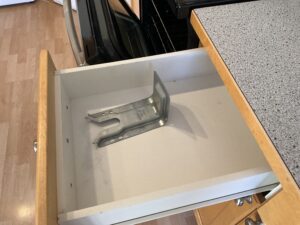
Architectural service
Any practice involving the art and science of building design or construction of any structure or grouping of structures and the use of space within and surrounding the structures or the design for construction, including but not specifically limited to, schematic design, design development, preparation of construction contract documents, and administration of the construction contract.
Automatic safety controls
Devices designed and installed to protect systems and components from unsafe conditions.
ABS
A type of black plastic pipe commonly used for waste water lines
Aggregate
Crushed rock or stone.
Air chamber
A vertical, short air-filled pipe that prevents water hammer by absorbing pressure when water is shut off quickly at the faucet or valve. These can usually be found on the laundry machine waterlines.
Air Conditioner Condenser
A component within the outside fan unit of the air conditioning system. The condenser discharges the heat taken from the inside air and disperses it to the
outside.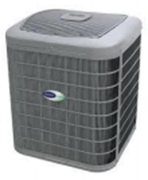
Alligatoring
A course checking pattern on the surface of a material. Typically caused by aging, exposure to sun and/or loss moisture/volatiles.
Ampacity
Refers to how much current a wire can safely carry. For example, a 12 gauge electrical copper wire can safely carry up to 20 amps.
Asphalt
A bituminous material employed in roofing and road paving materials because of its waterproofing ability.
Backdrafting
How does backdrafting happen?
Fuel-fired water heaters, boilers, wall heaters, and furnaces are designed to exhaust the by-products of combustion to the outdoors through a flue(chimney). These hot gases rise through the flue and exit the home because they are not as dense as indoor air. The pressure differential that allows for the release of combustion gases can be overcome by unusually low indoor air pressure caused by a high rate of expulsion (exhausted) air into the outdoors through exhaust fans, fireplaces, and dryers. When this happens, combustion gases can be sucked back into the house through the chimney and potentially harm or kill building occupants. Improperly configured flues or flue blockages can also cause backdrafting.
See blog #2 & #3 at X-tremeinspections.ca
Backfill
The replacement of excavated earth into a trench or pit.
Ballast
A transformer that steps up the voltage in a fluorescent lamp.
Balusters
Vertical members in a stair railing used between the top rail and bottom rail. Sometimes referred to as pickets or spindles.
Base sheet
The bottom layer of a built-up roofing system, normally used on a flat roof. Bay window
A window space projecting outward from the walls of a building.
Beam
A structural member transversely supporting a load. A structural member carrying building loads or weight from one support to another. Sometimes called a girder.
Bearing wall
A wall that supports any vertical load in addition to its own weight.
Birds-mouth cut
A “V” notched cut-out in a roof rafter which crosses over the outside wall, this notch forms a locking point which helps to anchor the top of the wall to the
roof framing. Also called a heel cut.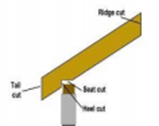
Bitumen
A term commonly applied to various mixtures of naturally occurring solid or liquid hydrocarbons, excluding coal. These substances are described as bituminous. Asphalt is a bitumen.
Blocking
Small wood pieces to brace framing members or to provide a nailing base for gypsum board or panelling.
Board and batten
a method of siding in which the joints between vertical placed boards or plywood are covered by narrow strips of wood.
Bottom chord
The lower or bottom horizontal member of a roof truss.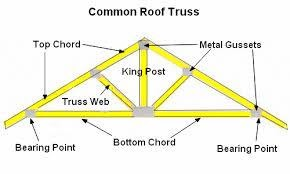
Brick tie
Metal stainless steel strips or wires that are inserted into the mortar joints of the brick veneer. These ties hold the veneer wall to the main building wall behind the veneer.
Brick veneer
A vertical facing of brick used to clad a building. Brick veneer is not a load bearing component.
Building paper
A general term for papers, felts and similar sheet materials used in buildings without reference to their properties or uses. Generally, comes in long roles.
Built up roofing
A roofing composed of 3 to 5 layers of asphalt felt laminated with a tar product, pitch or asphalt. The top layer is finished with crushed slang or gravel. Generally used on felt or low pitched roofs.
Butt joint
The junction where the ends of building materials meet. To place materials, end to end or end to edge without overlapping.
Can’t strip
A triangular-shaped piece of lumber used at the junction of a flat deck and a wall to prevent cracking of the roofing which is supplied over it.
Cantilever
Any part of a structure that projects beyond its main support and is balanced on it.
Cap Flashing
The flashing covering at the top of a wall or a horizontal surface to prevent water from migrating behind the base flashing.
Cap Sheet
The top or last layer in modified bitumen roofing.
Casement window
A window with hinges on one of the vertical sides and swings open like a door.
Ceiling joist
One of a series of parallel framing members used to support ceiling loads and supported in turn by larger beams, girders or bearing walls. Can also be roof joists.
Certificate of occupancy
A certificate issued by the local building authority and is required before anyone can occupy and live within the building. It is issued only after the local building authority has made all inspections and all monies and fees have been paid.
CFM
(cubic feet per minute) – a rating that expresses the amount of air a blower or fan can move in a given time. The volume of air that can pass through a opening in one minute.
Chase
A framed enclosed space around a flue pipe or a channel in a wall, or through a ceiling or something to lie in or pass through. I.e., The chimney chase passed through all the floors and exited above the roof.
Checking
Cracks that appear with age in many large timber members. The cracks run parallel to the grain of the wood. At first superficial, but in time, they may penetrate entirely through the member and compromise its strength.
Cleanup
An opening providing access to a drain line. Closed with a threaded plug.
Closed cut Valley
A method of roof valley treatment in which shingles from one side of the valley extend across the valley and up the other side by approximately 24 inches, while shingles from the other side are trimmed two inches from the valley centreline. The valley flashing is not exposed.
Collar tie
Approximately two-inch-thick wood members connecting opposite roof rafters. They serve to stiffen the roof structure.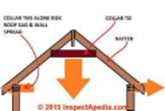
Column
A vertical structural compression member that supports loads acting in the direction of its longitudinal axis.
Combustion air and ventilation air
Ductwork installed in a furnace room to bring in fresh air, Combustion air ductwork is terminated close to the burner tubes of the furnace to supply fresh air for proper combustion. Ventilation air is through a similar set of ductwork which supplies fresh air into the heating air supply.
Compressor
A mechanical device that pressurizes a gas in order to turn it into a liquid, thereby allowing heat to be removed or added. A compressor is the main component of conventional heat pumps and air conditioners. In an air conditioning system, the compressor normally sits outside and has a large fan which is used to remove heat.
Concrete board or cement board
A panel made out of concrete and fiberglass, usually used as a tile backing material.
Condensate drain line
The pipe that runs from the air conditioning cooling coil to the exterior or internal building drain. Warm air that has been cooled will normally drop its moisture. This moisture is normally collected in a pan or trough system and directed down a small plastic pipe to a floor drain or similar receptacle.
Condensing unit
The outdoor component of a cooling system. It includes a compressor and condensing coil designed to give off heat.
Conduit, electrical
A pipe, usually metal, in which wire is installed. The pipe serves to protect the wire.
Control joint
Tooled, straight grooves made on concrete floors or structures to control where the concrete should crack.
Cooling load
the amount of cooling required to keep a building at a specified
temperature during the summer.
Corbel
To build out one or more courses of brick or stone from the face of a wall. This may be decorative, or serve to support a structural component.
Counterflashing
A metal flashing used as a first line of defence, usually used to cover another flashing to prevent moisture entry.
Course
A row of shingles or roll roofing running the length of the roof. Parallel layers of building materials such as bricks, or siding laid up horizontally.
Crawlspace
A shallow space below a building, normally enclosed by the foundation walls.
Cricket
A saddle shaped, peaked mini-roof construction connecting a sloping roof plane with a wall or chimney. Designed to encourage water to drain away from the chimney or wall joint.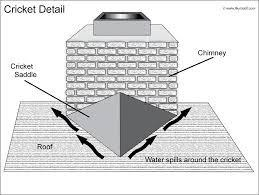
Culvert
Round, corrugated drain pipe installed beneath a driveway and parallel to and near the street.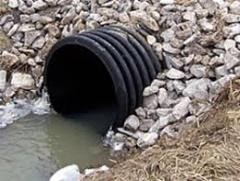
Cupping
A type of warping that causes boards or shingles to curl up at the edges. Typically caused by uneven drawing or loss of moisture or volatile’s
Curb
The short elevation of a supporting element above the deck of a roof. Normally a box on which a skylight or piece of mechanical equipment is attached.
Curtain wall
An exterior building wall that is supported entirely by the building structure, rather than being self supporting or load bearing.
Describe
To report a system or component by its type or other observed,
significant characteristics to distinguish it from other systems or components
Dismantle
To take apart or remove any component, device or piece of equipment
that would not be taken apart or removed by a homeowner in the course of a normal and routine home owner’s maintenance.
Damper
A metal plate or door installed within the ductwork of an air handling system or furnace/fireplace, for regulating the draft or flow of air.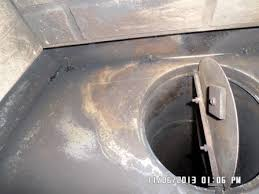
Damp proofing
The black, tar -like material applied to the exterior of a foundation wall. Damp proofing is used to minimize the moisture penetration into the concrete wall.
Deck
The surface, installed over the supporting framing members, to which the roofing is applied. As in roof deck.
Dedicated circuit
An electrical circuit that serves only one appliance or a series of electrical devices (such as smoke detectors) that serve one function only. A dedicated circuit should be installed for a freezer, so their would be no other appliances that may cause the main breaker to switch off, thus spoiling the contents of your freezer.
Dew-point
The temperature at which a vapour begins to deposit as a liquid. This applies especially to water in the atmosphere. Also related to the humidity content in that air. As in moisture on your windows, would indicate the dewpoint at which the air within your home against a cooler surface will deposit its moisture on the glass.
Disconnect
Electrical term, the large on off switch on your main service panel.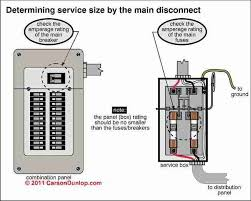
Diverter valve
A device that changes the direction of water flow from one faucet to another. Commonly found on your bathtub spout which would divert the water from that spout up to the showerhead
Dormer
A boxlike projection from the sloping plane of a roof that frames a window. Two types of dormers would be, a dog house dormer, and a shed dormer. The doghouse
dormers would be much smaller than the larger shed dormer.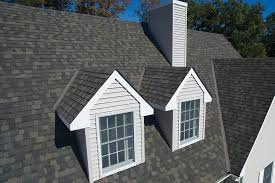
Downspout
The piping used for draining water from roof gutters. Also called a leader.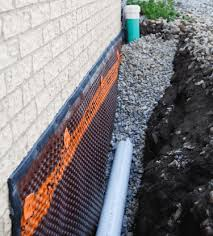
Drain tile
A perforated, corrugated plastic pipe laid underground beside the footing at the bottom of the foundation wall, this allows drain water seepage a path into a basement sump pump or the city’s storm sewer system. Drain tile prevents groundwater from accumulating underground at the footing, thus helping to prevent seepage through the foundation wall and into the basement.
Drip edge flashing
A metal flashing or edge treatment installed, usually, at the
lower edge/rake of a roof, which will cause water runoff to drop off the outer
protruding edge of the flashing instead of wicking back up and underneath and
running down the face of the building.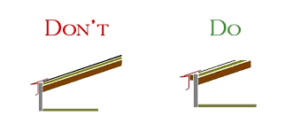 Managers actually
Managers actually
Ducts
Usually round or rectangular metal pipes installed for distributing warm or cold air from the heating system and/or air conditioning equipment throughout a building.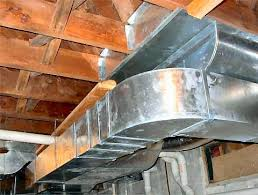
Efflorescence
Efflorescence is a white powder like substance that is typically located on an interior foundation wall where moisture is migrating from the outside to the interior surface through the concrete. The white powder is a result of a salt residue that occurs when the moisture dries from the surface. Efflorescence is an indication of excessive water against the concrete wall. With prolonged efflorescence, water seepage may occur in the future. The best defense against water seepage and efflorescence is good drainage of the soils near the foundation wall.
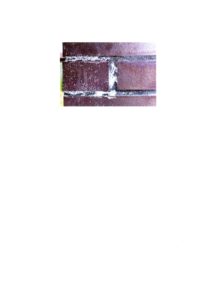
Engineering service
Any professional service or creative work requiring engineering education, training, and experience and the application of special knowledge of the mechanical, physical and engineering sciences to such professional service or creative work.
EIFS
Exterior Insulation Finishing System, or commonly called, synthetic stucco. An exterior cladding system that employs a relatively thin acrylic stucco coating over insulation panels.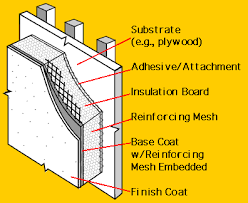
Elbow
A plumbing or electrical fitting that lets you change direction in runs of pipe or electrical conduit.
Evaporator coil
A part of the cooling system, found within the air stream that absorbs heat from air passing through it. This is commonly called the “A” coil, and is usually mounted above the circulating fan within the furnace Plenum system.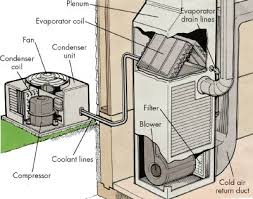
Expansion joint
A joint that allows for building material expansion and contraction caused by temperature changes. Expansion joints can be found running across concrete driveways and sidewalks, and on most concrete stucco wall systems.
Exposure
The portion of the roof or wall cladding material exposed to the weather after installation.
Further Evaluation
Examination and analysis by a qualified professional, tradesman or service technician beyond that provided by the home inspection.
Fascia
The vertical member attached to the ends of the roof structure and often the support member where the gutters are attached.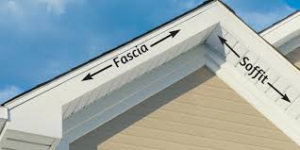
Felt
Fibrous material saturated with asphalt and used as an underlayment or part of a built-up roofing system. Felt is usually the first layer on the roof deck before the shingles are applied, and is normally referred to as 15 pound felt, 20 pounds felt, etc. which denounces the weight for durability purposes.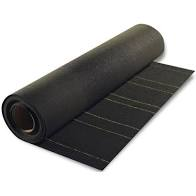
Finger joint
A manufacturing process of interlocking to shorter pieces of wood, end to end, to create a longer piece of dimensional lumber or moulding. This process is designed to eliminate twisting or warping. Often used in door jams and trim casings and are normally painted instead of stained.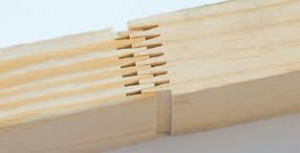
Fire stop
A solid, tight non-combustible material used in concealed spaces, such as attics or underfloor crawlspaces, that will help prevent the spread of fire and smoke
through wall penetrations or floor systems to other combustible materials. Fire stop material can be, drywall mud, drywall, concrete grout mixes, cement board etc. most fire stop materials must be approved by the authority having jurisdiction. (AHJ).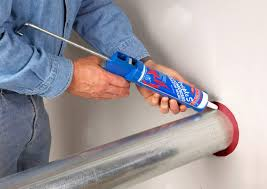
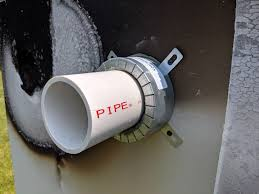
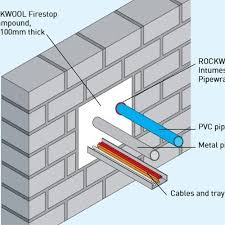
Flashing
A building component used to connect portions of a roof, deck, or siding material, etc. to another surface such as a chimney, wall, or vent pipe.
Flashings are often made out of various materials such as rubber, tar, aluminum, and is mostly intended to divert or prevent water entry at a connection point between two dissimilar materials.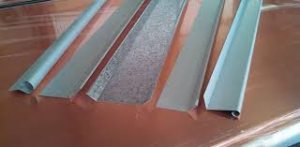
Flat work
Common word for concrete placement and finishing of floors, driveways, patios, sidewalks, etc.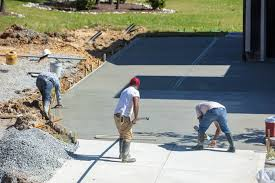
Flu
The space or passage in a chimney through which smoke, gas, or fumes ascend to the outside.
Footing
A thick strip of dimensional concrete, usually 18 inches wide and 8 inches deep, which supports the weight of the concrete wall and building, designed specifically to distribute the design weight of that building evenly over a designed area of ground. Footing thickness and width are designed for the weight bearing capacity of the soil underneath them.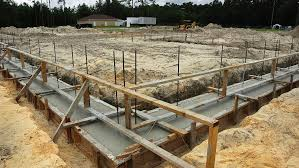
Forced air heating
A common form of heating with natural gas, propane, oil or electricity used as a fuel. Air is heated through a heat exchanger in the heating unit or furnace and distributed throughout the building through a set of metal ducts.
Forms
Temporary structure erected to contain concrete during placement and initial hardening.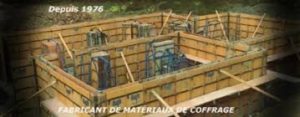
Foundation
The supporting portion of a structure below the first floor, normally concrete.
Framing
The structural wood, or steel members of a building. Framing is normally done after the footings and concrete foundation have been completed. Framing includes the floor systems, wall systems and roof systems.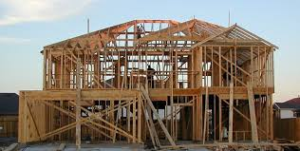
Frost line
The depth of frost penetration in soil and/or the depth at which the earth will freeze and swell. This depth varies in different parts of the country.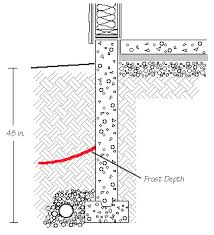
Furring
Strips of wood or metal applied to a wall or other surface to bring it even or flush with another surface. Also, to serve as a fastening base or for finishing materials.
Gable
A side wall, typically triangular that is formed by two sloping roof planes on either side. Gable walls can normally be found at the ends of a building.
Gable roof
A type of roof with sloping planes of the same pitch on each side of the ridge. The term Gable wall and gable roof are interchangeable, a gable roof will result in a gable wall below it.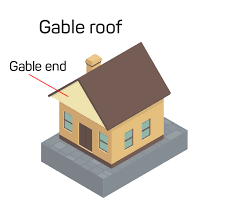
GFCI
Ground Fault Current Interrupter. An electrical wall receptacle or breaker switch that detects an uneven current flow. GFCI’s are normally located in wet areas. In the event of a ground fault (where you become the grounding path/ source) the GFCI breaker will trip and shut off the power, thus preventing someone from getting an electric shock. The GFCI device must trip within 200 milliseconds or lower.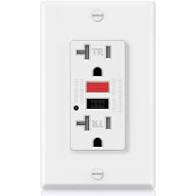
Glued laminated beam
Or glulam, A structural beam composed of wood (strips) laminations. The laminations are pressure bonded with adhesives. Glulam beams have a greater loadbearing capacity than conventional lumber beams.
Granules
Crushed rock coated with ceramic material and applied to the exposed surface of asphalt roofing products. These granules add colour and reduce ultraviolet degradation. Copper compounds may be added to help make them algae resistant.
Grout
Concrete mortar, made of such consistency that it will flow into the joints and cavities between the tile and masonry work to fill the crevice level with the surface. Tile and stone grouts come in different consistencies and colours.
Gusset
A flat metal, wood, plywood, or similar type of material used to primarily provide a reinforcement/connection, at the intersection of wood members. Metal gussets are commonly used at the joints of wood trusses.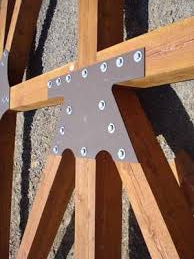
H beam
A steel beam with a cross section resembling the letter H.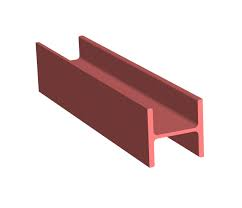
H clip
Small metal clips formed like an “H” that fits at the joints of two plywood/OSB sheets to stiffen the joint. Normally used on the roof sheathing.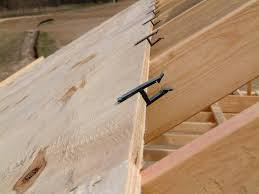
Header
A beam placed over a window or opening to support a floor joist or roof system load. The header is placed perpendicular to the joists.
Hearth
The fireproof area directly in front of a fireplace. Also, the inner or outer floor of a fireplace, usually made of brick, tile, or stone.
Heat pump
A device that uses compression and decompression of a gas to transfer heat and or cooling to or from a building. AKA an air conditioner.
Heating load
The amount of heating required to keep a building at a specified temperature during the winter, based on an outside design temperature.
Hip
The external angle formed by the meeting of two sloping sides of a roof. Also, known as a hip roof, which is void of a gable end.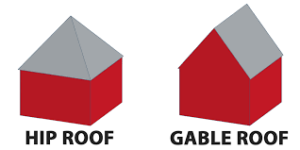
Honeycomb
A surface with the appearance of the honeycombs in a beehive. Also, any surface that has many small holes. Also called Segregation.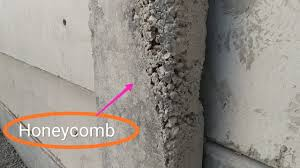
Hose bib
An exterior water faucet.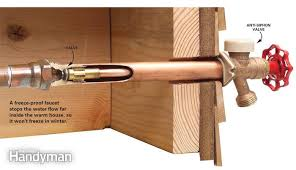
Hot wire
The wire that carries electrical energy to a receptacle or other device. In contrast to a neutral which carries electricity away. The black or red wires are normally hot wires, the white wire is a neutral wire, and the green wire is the equipment ground wire.
HVAC
An abbreviation for Heating, Ventilation, and Air Conditioning.
Inspector
A trained and qualified person hired by the client to examine and report on systems and components of a home or a building in accordance with a standard of inspection practices set out by the Association to which that inspector is a member in good standing with.
I beam
A steel beam with a cross section resembling the letter I.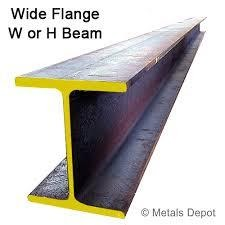
Ice damming
The buildup of ice and water at the eaves of a sloped roof. Melting snow on the roof refreezes at the roof overhang, causing the damming. Buildings with inadequate attic insulation, ventilation or with large roof projections beyond the exterior walls are more prone to ice damming.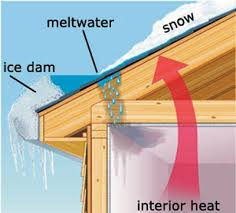
Jack post
A type of structural support made of metal, which can be raised or lowered through a series of pins and a screw to meet the height required. Typically used as a replacement for an old supporting member in a building.
Joist
One of a series of parallel floor framing members, as floor joists, or ceiling joists, and they are supported in turn by a large beam, girders or bearing walls underneath.
Joist hanger
A metal U-shaped item used like a pocket to support the end of a floor joist and attached with hardened nails to another bearing joist or beam.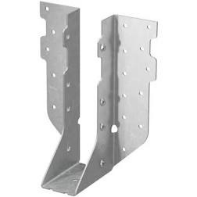
Knob and tube wiring
A common form of electrical wiring used before the second world war, when in good condition, it may still be functional for low amperage use such as smaller light fixtures. In this wiring method, a ceramic insulator or knob, is nailed to a framing member and the wire is fastened to that. Also, within a wall, a ceramic tube is inserted into a pre-drilled hole in the framing member and the wire is threaded through that. This is only a two-wire system with no equipment ground (green wire). The wires are normally run approximately six inches apart. It is deemed unsafe for higher demands, and is normally recommended to be replaced with more up to date methods.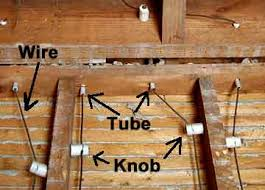
Lath
A building material of narrow wood, metal, gypsum, or insulation board that is fastened to the frame of a building to act as a base for plaster, shingles, or tiles. The term “lath and plaster”, refers to the system used before drywall sheets became common practice.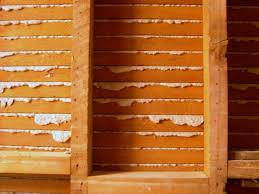
Lattice
An open framework of crisscrossed wood or metal strips that form regular, patterned spaces.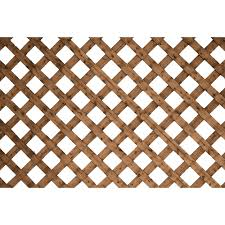
Leader
See downspouts.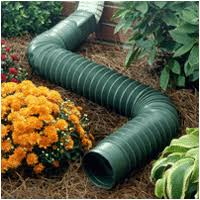
Ledger
The wood or metal members, attached to a beam, wall studding, or wall used to support joists or rafter ends. Commonly used as “deck ledger board”, which is the board fastened to the wall to support the opposite end of the deck floor joists from the beam.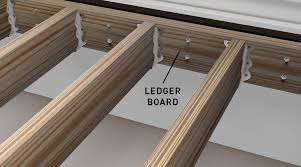
Lintel
A horizontal structural member that supports the load over an opening such as a door or window. In some circles this is also called a header.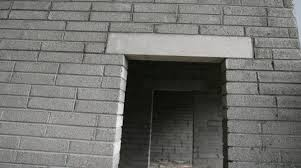
Loadbearing wall
A wall supporting its own weight and some other structural elements of the building such as the roof and floor structures.
Louver
A vented opening into a room that has a series of horizontal slats and arranged to permit ventilation but to exclude rain, snow, light, insects, or other living creatures.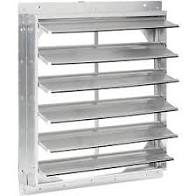
Mansard roof
A roof with two sloping planes of different pitch on each of its two sides. The lower plane is steeper than the upper plane, and may be almost vertical. A mansard roof is popular with storage barns for hay on the upper floor.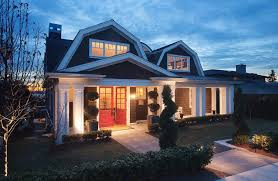
Masonry
Consisting of any stonework, brickwork, concrete, hollow tile, concrete block, or other similar building units or materials. Normally bonded together with mortar to form a wall.
Mechanical Damage
Mechanical damage is the loss of material due to a mechanical action.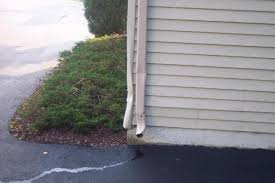
Modified bitumen roof
A roof covering that is typically composed of a factory fabricated composite sheet consisting of a copolymer modified bitumen, often reinforced with polyester and/or fiberglass, and installed in one or more layers. The membrane is commonly surfaced with field applied (on site) coatings, granules or metal foil. The roofing system may incorporate rigid insulation.
Mortise
A slot cut into a board, plank, or timber, usually edgewise, to receive the tenon, (or tongue) of another board, plank, or timber to form a tight joint.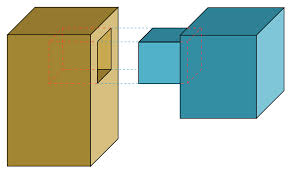
Mullion
A vertical divider in the frame between windows, doors, or other openings.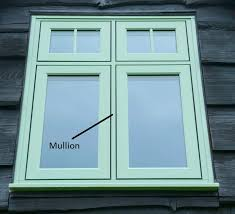
Normal Operating Controls
Devices such as thermostats, switches or valves intended to be operated by the building occupants.
Neutral wire
Usually colour-coded white, this wire carries electricity from a load (or appliances) back to the service panel.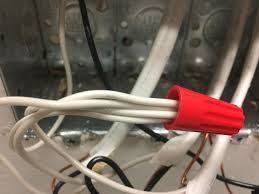
Newel post
The large starting post at the base and or top of a staircase to which the end of a stair guard railing or balustrade is fastened.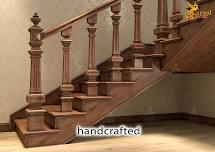
Nosing
The protruding edge of a moulding drip cap, or the front edge of a stair tread.
On Centre
The measurement of spacing for studs, rafters, and floor joists in a building from the centre of one member to the centre of the next. On Centre spacing will allow for sheet goods of even measurement (2, 4, 6, 8,) to land halfway on subsequent members for fastening to the framing member below the edge of that panel.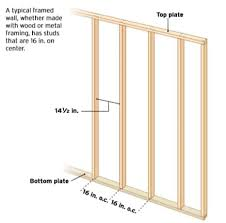
Open valley
A method of roof valley shingling in which the shingles on both sides of the valley are trimmed back along a chalk line snapped on each side of the valley. The shingles do not extend across the valley, the valley flashing below the shingles is exposed.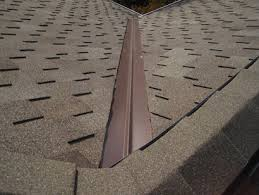
Open web steel joists
A series of floor joists constructed with open web members and positioned diagonally in between the top and bottom support cords. Open web floor joists allow for plumbing and heating pipes to run through the spaces or webbing, this allows for a cleaner ceiling with no box down framing required to hide ductwork and plumbing pipes. They are also desirable for faster mechanical installation.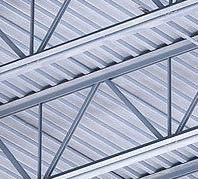
Oriented Strand Board
Commonly called OSB, are manufactured 4’ x 8’ wood panels made out of wood chips, glued and pressed, and somewhat oriented to the length of the panel. OSB panels are manufactured for different applications, and are primarily made up of fast growing weed trees. OSB panels are cheaper than plywood but the durability and longevity of these panels once they get wet is questionable.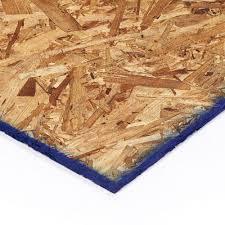
P-trap
A curved, U- section of a drainpipe that holds a water seal to prevent sewer gases from entering a building through a fixture drain pipe. P-traps are commonly found under sinks.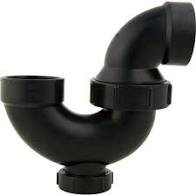
Parapet
The portion of an exterior wall that extends above the edge of a roof.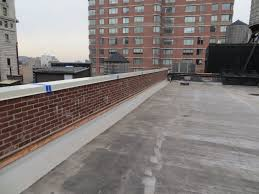
Parging
A thin layer of cement applied over masonry units or a walls surface for decorative or finishing purposes. Parging can be found around the base of a concrete foundation wall.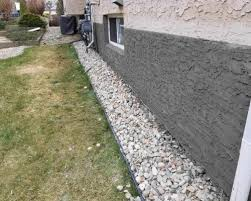
Partition
A wall that subdivides spaces within any story of a building or room.
Paver
Commonly masonry units, laid down to make a firm even surface on the exterior. Such as for patios and walkways.
Performance bond
an amount of money, (usually 10 % of the total price of the job) that a contractor must put on deposit with a governmental agency as an insurance policy that guarantees the contractor’s proper and timely completion of a project or job.
Perimeter drain
Typically, a four-inch perforated plastic pipe around the perimeter of a foundation wall footing that collects and diverts groundwater away from the foundation and into or toward a pre-determined drainage system.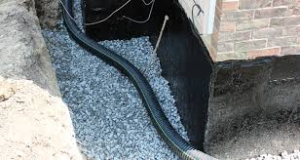
Pilot light
A small, continuous flame that ignites the main gas or oil burners when needed.
Pitch
The degree of roof incline expressed as a ratio of the rise vertically, in feet to the span or distance travelled horizontally, in feet. Expressed as the roof pitch is 5/12. Which is five feet of rise for every 12 feet of run.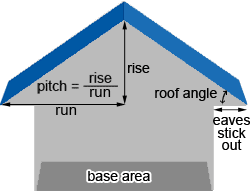
Plan view
Drawing of a structure with the view from overhead, looking down. Different than a 3D view.
Plate
Normally a horizontal member within a framed structure, such as:
(1) sill plate, a horizontal member anchored to a concrete or masonry wall;
(2) Sole plate, the bottom horizontal member of a framed wall;
or (3) top plate, the top horizontal member of a framed wall supporting ceiling joists, rafters, or other members.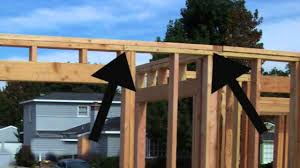
Plenum
The main supply air or return air duct leading from or into a heating or cooling unit. Other smaller pipes lead off the Plenum and form the heating/cooling runs into the rooms.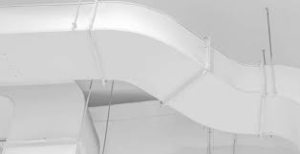
Plumbing stack
A large diameter plumbing vent pipe that penetrates the roof. The main plumbing stack receives the smaller diameter drain pipes from sinks and toilets and directs them into the main sewer drain. The main stack is normally plumbed up to the roof to allow for air to enter the plumbing system which enhances the waste water flow.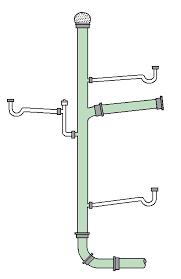
Ply
A term to denote the number of layers of roofing, felt paper, veneer in plywood, or layers in built up materials etc.
Point load
The point where a bearing/structural weight is concentrated and transferred to another structural member or component. Example, the main beam in a basement which holds up the floor structure above will usually have a steel post (commonly called, Tele-post, Lally post, Adjustable post) or posts in the centre of the beam or otherwise placed for structural stability. This post is then structurally supported on a reinforced concrete slab beneath the poured concrete floor in the basement.
Portland cement
Cement powder made by heating clay and crushed limestone into a brick and then grinding into a pulverized powder state. Other admixes are added to complete the cement composition required.
Post and Beam
A building method that uses hefty posts and beams to support an entire structure.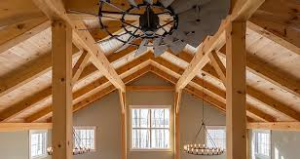
Power vent
A vent that includes a fan to speed up air flow.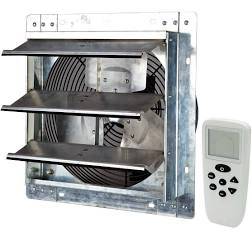
Pressure relief valve
A safety device mounted on a water heater or boiler. The relief valve is designed to release any high pressure in the vessel and thus prevent tank explosions. Incorporated in most pressure relief valves is a high temperature relief device as well. Commonly called a T P R valve, (Temperature and Pressure Relief Valve) the relief valve is set for 150 pounds per square inch pressure and/or 210 f degrees in water temperature, of which the valve will open and expel hot water.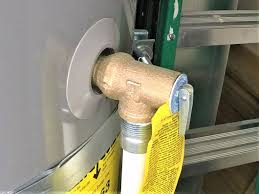
Pressure treated wood
Lumber that has been saturated with a preservative to resist rot and insects.
PVC or CP VC
(polyvinyl chloride) A type of white or light grey plastic pipe sometimes used for water supply lines and waste pipe. Not to be confused with the darker grey polybutylene water pipe, commonly known as poly B.
Quarry tile
A man-made or machine-made clay tile used to finish a floor or wall. Generally, six inches by six inches by one quarter inch thick.
Readily Accessible
Available for visual inspection without requiring moving of personal property, dismantling, destructive measures, or any action which will likely involve risk to persons or property.
Recreational Facilities
Spas, saunas, steam baths, swimming pools, exercise equipment, entertainment, athletic, playground or other similar equipment and associated accessories.
Representative Number
One component inspected out of several. A typical example or specimen of a group, quantity, or kind.
R- value
A measurement of insulation’s resistance to heat flow. The higher the R value the more effective the insulation. The R-value of insulation is contingent on the depth and density. Example; White blown in fiberglass insulation has an R-value of approx. 2.66 per inch of depth, you may have 15 inches of insulation in your attic, which would equal approximately R 40 of insulation value, but if it is “fluffed up,” and applied to loosely, you may only achieve half of the required R-value. You need to educate yourself to the density required for the R value you are trying to achieve. That may include the number of bags required per a given dimension in square feet.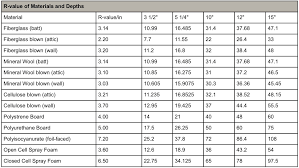
Rafter
A framing member that directly supports the roof sheathing. A rafter usually follows the angle of the roof, and may be part of a roof truss system.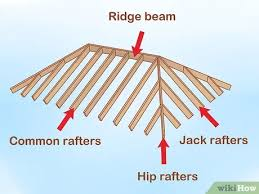
Rafter, hip
A rafter that forms the intersection of an external roof angle. Example, a hip roof, a 90 degree outside angle.
Rafter, valley
A rafter that forms the intersection of an internal roof angle. Example, a 90-degree inward angle.
Rake edge
The overhang of an inclined roof plane beyond the vertical wall below it. Example, the rake edge starts at the gutter and goes up the roof to the peak.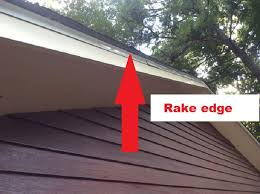
Rebar
Reinforcing bar. A ribbed steel bar installed in concrete form work and concrete structures designed to strengthen the concrete.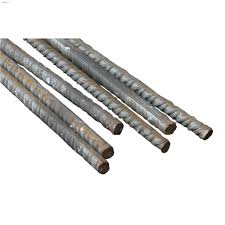
Refrigerant
A substance that remains a gas at low temperatures and pressure and can be used to transfer heat. Freon is an example.
Reglaze
The act of replacing a broken window.
Reinforcing
Steel rods or metal fiver placed in concrete slabs, beams column or columns to increase their strength.
Relief valve
A device designed to open if it detects excess temperature or pressure commonly found on water heating or steam producing systems.
Resilient flooring
A durable floor covering that has the ability to resume its original shape.
Retaining wall
Retaining wall A structure that holds back a slope or elevation of land that prevents erosion.
Ridge
The horizontal line at the junction of the top edges of two sloping roof surfaces.
Ridge vent
A venting system that has a continuous opening (about two inches wide) and continues along the length of the roof ridge. A ridge vent works in conjunction with the soffit venting at the bottom edge of the roof. The continuous opening is covered with a nylon mesh like material to resist insects and blowing snow, and the mesh is covered by a continuous plastic cap.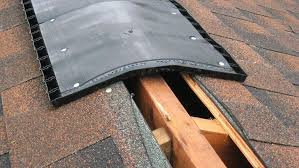
Riser
The vertical member between two stair treads.
Roll roofing
Asphalt roofing products manufactured in roll form, usually applied to flat roofs.
Romex
Romex A name brand of non-metallic sheathed electrical cable that is used for indoor wiring.
Roof deck
The roof surface, installed over the support framing members to which the roofing material is applied.
Roof sheathing
The wood panels or sheet material fastened to the roof rafters or trusses on which the shingle or other roof covering is applied.
Roof membrane
The layer or layers of waterproofing products that cover the roof deck.
Run, stair
the horizontal distance of a stair tread from the nosing to the riser at the back of the stair.
Saddle
Two sloping surfaces meeting in a horizontal ridge, used between the backside of a chimney, or other vertical surface, and a sloping roof. Used to divert water around the chimney or vertical surface.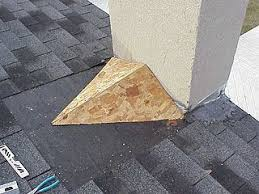
Sanitary sewer
A sewer system designed for the collection of waste water from the bathroom, kitchen and laundry rooms, and is usually not designed to handle stormwater.
Sash
The frame that holds the glass in a window, often the movable part of the window.
Saturated felt
A felt that is impregnated with tar or asphalt.
Scratch coat
The first coat of plaster or concrete, which is scratched with a tool to form a rough bonding surface for a second coat.
Scupper
An opening for drainage in a wall, curb or parapet wall.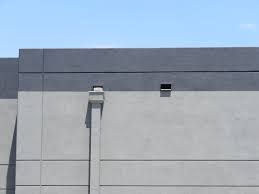
Sealer
A finishing material, either clear or pigmented, that is usually applied directly over raw wood or concrete for the purpose of sealing the wood or concrete surface in preparation for the finished and final coats.
Seasoning
Drying and removing moisture from Greenwood in order to improve its usability.
Service equipment
The main control gear at the electrical service entrance, such as circuit breakers, switches, and fuses.
Service lateral
Underground power supply line.
Shake
A wood roofing material, normally cedar or redwood.
Sheathing
Sheets or panels used as roof deck material. Panels that lie between the studs and the siding of a structure.
Short circuit
A situation that occurs when hot and neutral wires come in contact with each other. Fuses and circuit breakers protect against fire that could result from a short circuit.
Sill
The two by four or two by six wood plate framing member that lays flat against and bolted to the foundation wall and upon which the floor joists are attached.
Skylight
A dome shaped plastic window that is located on the roof.
Slab on grade
A type of foundation with a concrete floor which is placed directly on the soil. In cold climates the edge of the slab is thicker and carries down to below the frost line.
Sleeper
Usually a wood member that serves to support equipment. Also, sleepers can be pressure-treated dimensional lumber, glued or fastened to a concrete floor system for the sole purpose of supplying space for insulation or air movement and providing a nailing surface for sheet goods which will support a finished floor.
Soffit
The finished underside of the roof eaves. A small ceiling like space, often out of doors, such as the underside of a roof overhang.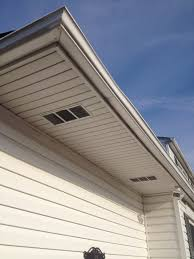
Solid waste pump
A pump used to lift wastewater to a gravity sanitary sewer line. Usually used in basements and other locations which are situated below the level of the city sewer connection.
Spalling
The cracking and breaking away of the surface of a material.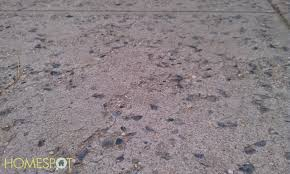
Span
The clear distance that a framing member carries a load without support.
Splash block
A pad placed under the lower end of a downspout to divert the water from the downspout away from the building.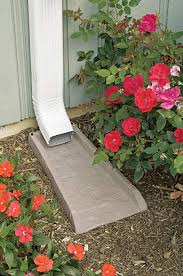
Stair stringer
The supporting member for stair treads. Can be a notched plank or a steel member.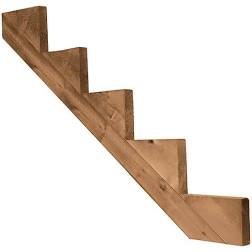
Starter strip
Asphalt roofing applied at the eaves that provides protection by filling in the spaces under the cut outs and joints of the first course of shingles.
Step flashing
A flashing system application method used where a vertical surface meets a sloping roof plane. Step flashing is usually 2 to 4 inches longer than the exposed face of the shingles, bent to a 90 degree angle, and each leg is about 2 ½ inches tall. Each row of shingles which protrudes away from a wall, is covered at the wall and shingle intersection so there is a consistent overlapping of the shingles on each course of roofing material, the flashing is applied in a step fashion which progresses up the slope of the roof as the shingles are applied. The siding material then is applied over the top edge of the step flashing and a water shedding system is constructed.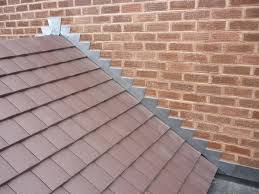
Story
That part of a building between any floor or between the floor and roof.
Storm collar
A metal flashing used to seal around a penetration in a roof.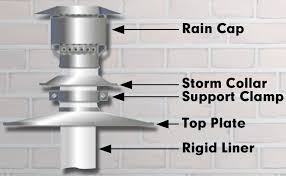
Storm sewer
A sewer system designed to collect stormwater, separate from the wastewater system.
Storm window
An extra window usually placed outside of an existing window, as additional protection against cold weather, or damage.
Stucco
An outside exterior concrete finish made with Portland cement as its base.
Stud
One in a series of slender wood or metal vertical structural members placed as supporting elements in walls and partitions.
Stud framing
A building method that distributes structural loads to each of a series of relatively lightweight studs.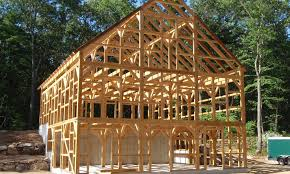
Sump
A pit or large plastic bucket/barrel inside a basement, designed to collect groundwater from the footings or under the slab.
Sump pump
a submersible pump in a sump pit that pumps any excess groundwater to the storm sewer or directly to the outside.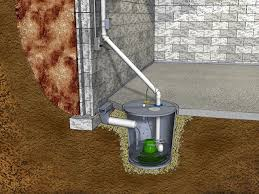
Suspended ceiling
A ceiling system supported by hanging it from the overhead structural framing. Sometimes called a T-bar ceiling.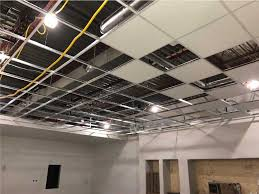
Significantly Deficient
Unsafe or not functioning. Lacking some element or characteristic, defective.
Solid Fuel Burning Appliance
A hearth and fire chamber or similar prepared place in which a fire may be built and which is built in conjunction with a chimney.
Solid fuel
A domestic or industrial fuel, such as coal, or wood that is solid rather than an oil or gas.
Structural component
A component of a building that supports non-variable forces or weights (dead loads) and variable forces or weights (live loads).
System
A combination of interacting or interdependent components, assembled to carry out one or more functions.
Technically Exhaustive
An investigation that involves dismantling, the extensive use of advanced techniques, measurements, instruments, testing, calculations, or other means that would be above and beyond the standard of practices or accepted procedures for home and building inspections.
Termites
Insects that superficially resemble ants in size, general appearance, and habit of living in colonies, hence, they are frequently called “white ants”. Subterranean termites est. themselves in buildings not by being carried in with the lumber, but entering from ground nests after the building has been constructed. If unmolested, they eat out the wood work, leaving a shell of sound would to conceal their activities, and damage may proceed so far as to cause collapse of parts of a structure before discovery.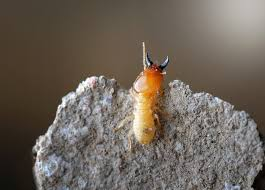
Tempered
Strengthened. Tempered glass will not shatter nor create shards, but will pelletize like an automobile window when hit. Tempered glass is required in tub and shower enclosures. Terra-cotta A ceramic material moulded into Masonry units. Threshold The bottom metal, concrete, or wood plate of an exterior door frame. They may be adjustable to keep a tight fit with the door slab. Total nailing To drive a nail in at a angle. Method used to secure floor joists to the top plate. Not acceptable for securing joists flush to the header or beam.
Terra-cotta
Terra-cotta A ceramic material moulded into Masonry units.
Threshold
The bottom metal, concrete, or wood plate of an exterior door frame. They may be adjustable to keep a tight fit with the door slab.
Total nailing
To drive a nail in at a angle. Method used to secure floor joists to the top plate. Not acceptable for securing joists flush to the header or beam.
Tongue and groove
A joint made by a tongue that fits into a corresponding groove in the edge of another board to make a tight flush joint. Typically, the subfloor plywood is tongue and groove.
Top cord
The upper or top member of a truss.
Trap
A plumbing fitting that holds water to prevent air, gas, and vermin from entering into a building.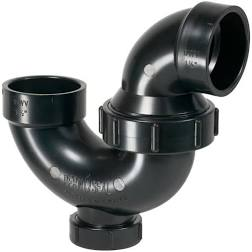
Tread
The walking surface board in a stairway on which the foot is placed.
Treated lumber
A wood product which has been impregnated with chemicals to reduce damage from wood rot or insects. Often used for the portions of a structure which is likely to be in contact with soil and water.
Truss
An engineered and manufactured roof support member with zigzag framing members. Trusses do the same job as rafters but they are designed to have a longer and stronger span than rafters with common lumber.
Truss up-lift
Roof truss uplift occurs when the bottom chord of the truss is exposed to significantly different moisture and/or temperature conditions than the rest of the roof truss. The bottom chords of the truss are buried in heavy insulation,
12 inches or more thick. In the winter the warm temperature from the ceiling below and the thickness of the insulation keeps the bottom chord dry, causing them to shrink. The top chords (above the insulation) are absorbing moisture and being kept damp with the higher humidity in the attic. The dampness of the top chords of the trusses causes them to expand. This differential movement in the top and bottom chord of the trusses causes them to arch up in the center.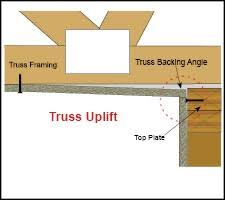
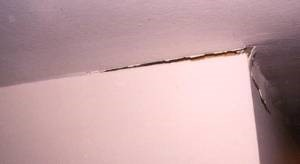
Underfloor Crawlspace
The area within the confines of the foundation and between the ground and the underside of the floor. A crawlspace is normally the limited, non-livable space between the foundation and first floor.
UFFI
Urea Formaldehyde Foam Insulation, a foam insulation blown into existing walls.
Ultraviolet degradation
A product or coating that is showing degradation in certain performance limits caused by exposure to ultraviolet light.
Underlayment
A quarter-inch or similar thickness panel placed over the subfloor to provide a smooth even surface for the floor finishing product. A secondary roofing layer that is waterproof or water resistant, installed on the roof deck and beneath shingles or other roof finishing layers.
UV Rays
Ultraviolet rays from the sun.
Valley
The inward angle formed by two intersecting, sloping roof planes, since it naturally becomes a water channel, additional attention to waterproofing is desirable.
Vapour barrier
A building product installed on exterior walls and ceilings under the drywall and on the warm side of the insulation, interior. It is used to retard or prevent the movement of water vapour into the walls and reduce or prevent condensation within them.
Vent
A pipe or duct work allowing the flow of air and gases to the outside. In a plumbing system, the vent is necessary to allow sewer gas to escape to the exterior.
Vermiculite
a mineral closely related to Mica, with the faculty of expanding on heating to form lightweight material with insulation quality. Used as bulk insulation and also as aggregate in insulation in an acoustical plaster and in insulating concrete floors. Vermiculite is now considered hazardous, the vast majority of vermiculite in attic spaces may contain at least 1% asbestos.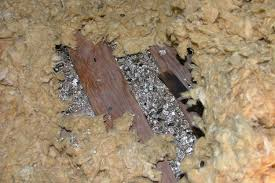
Water closet
A toilet.
Weatherstripping
Narrow sections of thin metal or other material installed to prevent the infiltration of air and moisture around windows and doors.
Weep holes
Small holes in exterior wall cladding systems that allow moisture to escape and air pressure to equalize in the cavity space.
Weep Screed
Pertaining to stucco and other concrete wall finishes. The purpose of a weep screed is to allow any moisture that gets absorbed behind the stucco to drain out. A weep screed is a “L “shaped flashing with drainage holes at the bottom edge. Weep screed is first applied to the bottom edge of the wall, below the top plate of the foundation wall behind it. The stucco is then applied to the wall and over the flashing. The very bottom edge of the flashing is left exposed which allows for any moisture to drain out.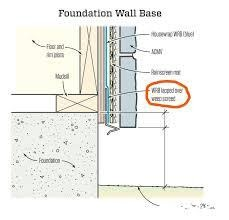
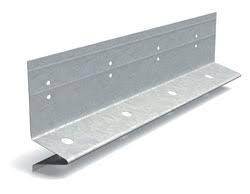
Wythe
A vertical layer of masonry that is one masonry unit thick.
Zone
The section of a building that is served by one heating or cooling loop because it has noticeably distinct heating or cooling needs.
Zone valve
A device, usually placed in the furnace room compartment, which controls the flow of water or steam to parts of the building, the zone valve will open and close in response to a thermostat within a room which will allow for water or steam to circulate to the heating device in that room.